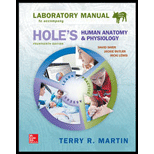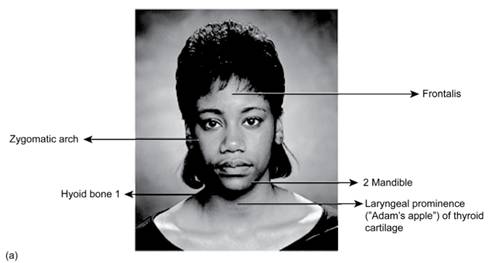
To label:
The surface feature of (a) − anterior head and neck, (b) − lateral head and neck, and (c) − posterior head and neck in the figure.
Introduction:
The neck is the connecting link between the head and torso. It is composed of many muscle attachments that play a vital role in regulating the body's homeostasis and impulses.
Explanation of Solution
The division created by significant muscle in the neck region is termed as the triangle of the neck. It permits the effective communication of the palpable masses present in the neck between healthcare professionals.
Pictorial Representation: Figure (a) represents the hyoid bone and mandible.

Figure (a) : Hyoid bone and mandible.
- The hyoid bone is a U shaped bone composed of a body, two lesser and two greater horns. It doesn't articulate with any other bone except muscles and ligaments of the neck. A cervical spine and mandibles protect it.
- The mandible is the largest and most reliable bone present inferiorly in the facial region. It forms the lower jaw and acts as a receptacle for the lower teeth and articulates on either side with the temporal bone, forming the temporomandibular joint.
- The sternocleidomastoid is a paired superficial bone present in the anterior neck portion. It protects branches of cervical plexus, the vertical neurovascular bundle of the neck, deep cervical lymph nodes from damage.
- The trapezius is a superficial broad; flat bone contributes to glenohumeral rhythm through attachments to scapula and clavicle. It mainly helps in flexion and extension of axial muscles.
Pictorial Representation: Figure (b) represents the sternocleidomastoid bone.

Figure 1: Sternocleidomastoid muscle.
Pictorial Representation: Figure (c) represents the trapezius muscle.

Figure 1: Trapezius muscle.
Thus, the anterior head and neck are necessary as they permit the movement of the head and neck and provide structural support to the head.
Want to see more full solutions like this?
Chapter 24 Solutions
Laboratory Manual for Holes Human Anatomy & Physiology Fetal Pig Version
 Human Anatomy & Physiology (11th Edition)BiologyISBN:9780134580999Author:Elaine N. Marieb, Katja N. HoehnPublisher:PEARSON
Human Anatomy & Physiology (11th Edition)BiologyISBN:9780134580999Author:Elaine N. Marieb, Katja N. HoehnPublisher:PEARSON Biology 2eBiologyISBN:9781947172517Author:Matthew Douglas, Jung Choi, Mary Ann ClarkPublisher:OpenStax
Biology 2eBiologyISBN:9781947172517Author:Matthew Douglas, Jung Choi, Mary Ann ClarkPublisher:OpenStax Anatomy & PhysiologyBiologyISBN:9781259398629Author:McKinley, Michael P., O'loughlin, Valerie Dean, Bidle, Theresa StouterPublisher:Mcgraw Hill Education,
Anatomy & PhysiologyBiologyISBN:9781259398629Author:McKinley, Michael P., O'loughlin, Valerie Dean, Bidle, Theresa StouterPublisher:Mcgraw Hill Education, Molecular Biology of the Cell (Sixth Edition)BiologyISBN:9780815344322Author:Bruce Alberts, Alexander D. Johnson, Julian Lewis, David Morgan, Martin Raff, Keith Roberts, Peter WalterPublisher:W. W. Norton & Company
Molecular Biology of the Cell (Sixth Edition)BiologyISBN:9780815344322Author:Bruce Alberts, Alexander D. Johnson, Julian Lewis, David Morgan, Martin Raff, Keith Roberts, Peter WalterPublisher:W. W. Norton & Company Laboratory Manual For Human Anatomy & PhysiologyBiologyISBN:9781260159363Author:Martin, Terry R., Prentice-craver, CynthiaPublisher:McGraw-Hill Publishing Co.
Laboratory Manual For Human Anatomy & PhysiologyBiologyISBN:9781260159363Author:Martin, Terry R., Prentice-craver, CynthiaPublisher:McGraw-Hill Publishing Co. Inquiry Into Life (16th Edition)BiologyISBN:9781260231700Author:Sylvia S. Mader, Michael WindelspechtPublisher:McGraw Hill Education
Inquiry Into Life (16th Edition)BiologyISBN:9781260231700Author:Sylvia S. Mader, Michael WindelspechtPublisher:McGraw Hill Education





